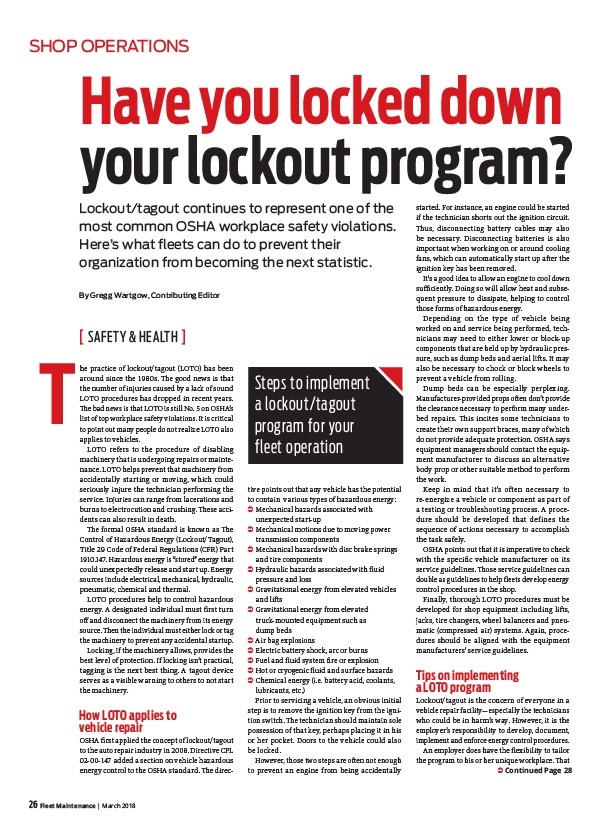
SHOP OPERATIONS
Have you locked down
your lockout program?
he practice of lockout/tagout (LOTO) has been
around since the 1980s. Th e good news is that
the number of injuries caused by a lack of sound
LOTO procedures has dropped in recent years.
Th e bad news is that LOTO is still No. 5 on OSHA’s
list of top workplace safety violations. It is critical
to point out many people do not realize LOTO also
applies to vehicles.
LOTO refers to the procedure of disabling
machinery that is undergoing repairs or maintenance.
LOTO helps prevent that machinery from
accidentally starting or moving, which could
seriously injure the technician performing the
service. Injuries can range from lacerations and
burns to electrocution and crushing. Th ese accidents
can also result in death.
Th e formal OSHA standard is known as Th e
Control of Hazardous Energy (Lockout/Tagout),
Title 29 Code of Federal Regulations (CFR) Part
1910.147. Hazardous energy is “stored” energy that
could unexpectedly release and start up. Energy
sources include electrical, mechanical, hydraulic,
pneumatic, chemical and thermal.
LOTO procedures help to control hazardous
energy. A designated individual must fi rst turn
off and disconnect the machinery from its energy
source. Th en the individual must either lock or tag
the machinery to prevent any accidental startup.
Locking, if the machinery allows, provides the
best level of protection. If locking isn’t practical,
tagging is the next best thing. A tagout device
serves as a visible warning to others to not start
the machinery.
How LOTO applies to
vehicle repair
OSHA fi rst applied the concept of lockout/tagout
to the auto repair industry in 2008. Directive CPL
02-00-147 added a section on vehicle hazardous
energy control to the OSHA standard. Th e directive
26 Fleet Maintenance | March 2018
points out that any vehicle has the potential
to contain various types of hazardous energy:
Mechanical hazards associated with
unexpected start-up
Mechanical motions due to moving power
transmission components
Mechanical hazards with disc brake springs
and tire components
Hydraulic hazards associated with fl uid
pressure and loss
Gravitational energy from elevated vehicles
and lift s
Gravitational energy from elevated
truck-mounted equipment such as
dump beds
Air bag explosions
Electric battery shock, arc or burns
Fuel and fl uid system fi re or explosion
Hot or cryogenic fl uid and surface hazards
Chemical energy (i.e. battery acid, coolants,
lubricants, etc.)
Prior to servicing a vehicle, an obvious initial
step is to remove the ignition key from the ignition
switch. Th e technician should maintain sole
possession of that key, perhaps placing it in his
or her pocket. Doors to the vehicle could also
be locked.
However, those two steps are oft en not enough
to prevent an engine from being accidentally
started. For instance, an engine could be started
if the technician shorts out the ignition circuit.
Th us, disconnecting battery cables may also
be necessary. Disconnecting batteries is also
important when working on or around cooling
fans, which can automatically start up aft er the
ignition key has been removed.
It’s a good idea to allow an engine to cool down
suffi ciently. Doing so will allow heat and subsequent
pressure to dissipate, helping to control
those forms of hazardous energy.
Depending on the type of vehicle being
worked on and service being performed, technicians
may need to either lower or block-up
components that are held up by hydraulic pressure,
such as dump beds and aerial lift s. It may
also be necessary to chock or block wheels to
prevent a vehicle from rolling.
Dump beds can be especially perplexing.
Manufacturer-provided props oft en don’t provide
the clearance necessary to perform many underbed
repairs. Th is incites some technicians to
create their own support braces, many of which
do not provide adequate protection. OSHA says
equipment managers should contact the equipment
manufacturer to discuss an alternative
body prop or other suitable method to perform
the work.
Keep in mind that it’s often necessary to
re-energize a vehicle or component as part of
a testing or troubleshooting process. A procedure
should be developed that defines the
sequence of actions necessary to accomplish
the task safely.
OSHA points out that it is imperative to check
with the specifi c vehicle manufacturer on its
service guidelines. Th ose service guidelines can
double as guidelines to help fl eets develop energy
control procedures in the shop.
Finally, thorough LOTO procedures must be
developed for shop equipment including lift s,
jacks, tire changers, wheel balancers and pneumatic
(compressed air) systems. Again, procedures
should be aligned with the equipment
manufacturers’ service guidelines.
Tips on implementing
a LOTO program
Lockout/tagout is the concern of everyone in a
vehicle repair facility—especially the technicians
who could be in harm’s way. However, it is the
employer’s responsibility to develop, document,
implement and enforce energy control procedures.
An employer does have the fl exibility to tailor
the program to his or her unique workplace. Th at
T
Lockout/tagout continues to represent one of the
most common OSHA workplace safety violations.
Here’s what fl eets can do to prevent their
organization from becoming the next statistic.
By Gregg Wartgow, Contributing Editor
Continued Page 28
SAFETY & HEALTH
Steps to implement
a lockout/tagout
program for your
fleet operation